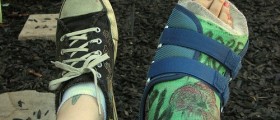
Carpal tunnel syndrome is a medical condition characterized by various changes in sensation of the arm, hand and fingers due to irritation of the median nerve, one of the 5 main nerves of the brachial plexus. The median nerve reaches the hand through the carpal tunnel. The tunnel is located in the wrist and apart from the aforementioned nerve it also contains nine tendons of the hand muscles. Since the tunnel cannot expand once some swelling inside occurs, it is obvious that pressure build-up will at first irritate the nerve and then, perhaps, cause even more severe damage to the nerve. In the majority of cases patients report numbness and tingling while the overall performance with the affected hand is significantly reduced.
Surgery of the Hand
The field of hand surgery is rather delicate and comprises both surgical and conservative treatments both of which are essential for conditions, infections and injuries affecting the hand as well as the entire upper extremity. Medical professionals that are involved in hand surgery are graduates of general surgery, orthopedic surgeons and plastic surgeons. Orthopedic and plastic surgeons are actually the most qualified medical experts in the field and they are actually masters of hand surgery, being familiar with all the structures in the hand and able to manipulate these in order to achieve desirable results. An expert in hand surgery must have completely approved fellowship training in the field and he/she is supposed to meet a number of practice requirements. He/she is also due to be qualified enough to take the " Certificate of Added Qualifications in Surgery of the Hand" examination. While plastic surgeons mainly deal with a so called 'replant' surgeries and repair aesthetic damage to the hand, orthopedic surgeons mostly focus on conditions affecting function of tendons, muscles and bones. They are, in fact of vital importance when it comes to complex fractures of the hand and trauma to the carpal bones that interfere with movement of the wrist.
There is a whole variety of operations which hand surgeons perform on a regular basis. Some of these are repairs of fractures, release of entrapped tendons, transfer or other kind of repair of tendons, reconstruction after severe injuries, repair of deformities caused by rheumatic diseases and congenital deformities etc. One of the most significant achievements of this field of surgery is microsurgical reattachment of amputated digits and limbs. This type of surgery is rather delicate and requires impeccable knowledge and highly developed skills.
Carpal Tunnel Syndrome
Speaking of carpal tunnel syndrome it is essential to mention that surgery does not have to be a treatment option for all patients. Some of them will completely recover with conservative approach.
Now, the syndrome itself usually develops without any reasonable explanation. Pressure to the median nerve may be triggered by various factors including swelling of the nearby tendons, joint dislocation, fractures of different kind as well as rheumatoid arthritis. Furthermore, people in whom the wrist is bent for many hours the risk of carpal tunnel syndrome is much higher compared to other individuals. So, those working with vibrating tools or on an assembly line who are engaged in prolonged and repeated Flexing of the wrist may eventually develop the condition. Finally, even though many people think that extensive computer use may precipitate carpal tunnel syndrome there is no sufficient evidence that might prove this theory correct.
As far as symptoms and signs are concerned, these may vary a lot but are mostly in the form of pain of different intensity, numbness and tingling. These unpleasant sensations typically affect the thumb, index, middle and the ring finger. The uncomfortable sensations generally occur at night, at rest. They additionally bother patients when activities such as driving or reading a newspaper are performed. The most severe forms of carpal tunnel syndrome cause clumsiness and significantly reduced grip. Fortunately, permanent damage to hand structures such as atrophy of the muscles at the base of the thumb rarely occur.
Diagnosing carpal tunnel syndrome is relatively easy. The patient's history, X-ray and laboratory tests may be sufficient enough for confirming the condition. However, it is essential for patients to additionally undergo electrodiagnostic studies, both nerve conductive velocities and electromyogram which determine damage to the affected nerve and the muscle innervated by the nerve.
Treatment is, as it has already been mentioned, in the beginning conservative and later when all else fails surgical. It is crucial to bring all the conditions that might have triggered the syndrome under control. The painful wrist should be splinted and immobilized for certain period of time. This way pressure to the nerve is reduced and it has a chance to recover. Swelling may be additionally treated with steroid injections. Finally, surgery includes decompression of the nerve by cutting the ligament that form the roof of the tunnel. After the surgery patients may need months to fully restore the function of the hand and the operated wrist.
















Your thoughts on this
Loading...